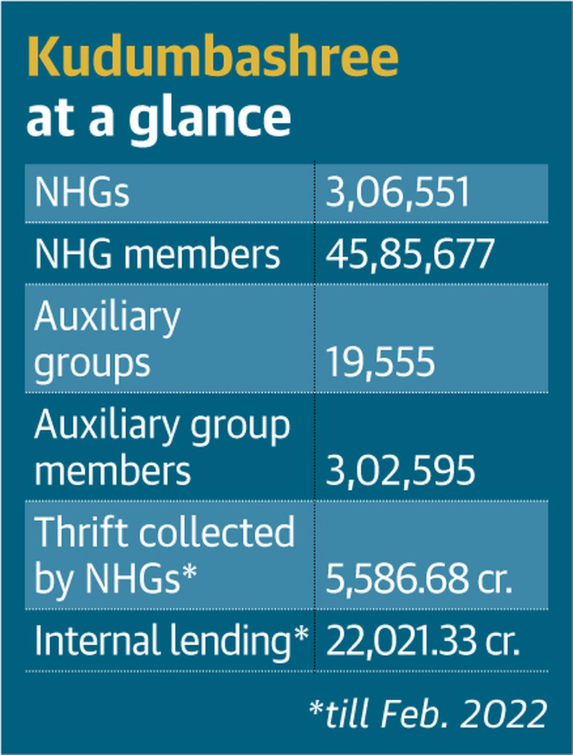Kudumbashree Model for SHG in India
2023 MAY 25
Mains >
Social justice > Poverty and Hunger > Self Help Groups
IN NEWS:
- Recently, President Droupadi Murmu inaugurated the silver jubilee celebrations of Kudumbashree, the largest self-help group network in the country.
KUDUMBASHREE:
- Kudumbashree is the poverty eradication and women empowerment programme implemented by the State Poverty Eradication Mission (SPEM) of the Government of Kerala. The name Kudumbashree in Malayalam language means ‘prosperity of the family’.
- It was set up in 1997 following the recommendations of a three member Task Force appointed by the State government.
- It aims at the empowerment of women, through forming self-help groups and encouraging their entrepreneurial or other wide range of activities.
- Organisational Structure Of Kudumbashree:
- Kudumbashree is essentially a community network that covers the entire State of Kerala.
- It consists of a three tier structure with Neighbourhood Groups (NHGs) as primary level units, Area Development Societies (ADS) at the ward level, and Community Development Societies (CDS) at the local government level.
- It is arguably one of the largest women’s networks in the world.
SIGNIFICANCE OF KUDUMBASHREE:
- Credit mobilization:
- Kudumbashree successfully raises and mobilises financial resources in a unique way by encouraging the poor to save and providing them cheap credit.
- The Thrift and Credit Societies are formed with the objective of encouraging the poor women to save their meagre means to widen the resource base of the NHGs.
- It is interesting to note that more than 90% of the savings in the thrift societies are given away as loans.
- The priority-based disbursement and release of funds are decided at the weekly NHG gathering.

- Address the needs of less privileged women:
- Built around three critical components: microcredit, entrepreneurship, and empowerment, the Kudumbashree initiative succeeded in addressing the basic needs of less privileged women.
- The neighbourhood bonding helped Kudumbasree explore many fields, including micro-enterprising, social collectives, agricultural initiatives, rural development projects, running palliative care units, and forging compassion initiatives.
- Statistics show that the majority of economically backward rural women are working in Kudumbashree units, and they have seen a notable level of improvement in various socioeconomic characteristics.
- Community activities during crises:
- Kudumbasree played a large role in the large-scale mobilisation of women in community activities during the floods and the pandemic, be it community kitchens, assistance to COVID-19 affected people, or mask manufacture.
- Drawing women out of households into the public sphere:
- One of the biggest achievements of Kudumbashree has been drawing women out of households into the public sphere and building their individual capabilities.
- For instance, the election of 7,071 Kudumbashree members among the 21,854 elected representatives in the 2020 local body elections is an example of women building on their strengths.
- Also, over the years, Kudumbashree women have been involved in local-level planning for employment generation, poverty reduction, and social justice.
- Holistic approach to poverty reduction:
- Kudumbashree perceives poverty as a state of multiple deprivations. While monetary factors are considered to contribute to poverty, it is manifested predominantly in the form of deprivation of basic needs, facilities, and rights.
- Therefore, in the Kudumbashree model, to eradicate absolute poverty, the focus is on restoring the entitlements denied to the poor by enabling them access to those entitlements.
- Auxiliary groups:
- In 2021, Kudumbashree launched auxiliary groups for the social and economic empowerment of young women aged 18–40 years and to offer income-generating opportunities to educated women and give them a platform for making social interventions as well as the financial development of their families.
- Also, Kudumbashree is currently undertaking consultancy work on women empowerment in 13 other states.
CRITICISMS / CHALLENGES ASSOCIATED WITH KUDUMBASREE MODEL:
- Reduces women’s empowerment to a matter of credit:
- One criticism is that the mission reduces women’s empowerment to simply a matter of thrift and credit.
- Microcredit, microenterprises, and other income-generation activities dominate, with little importance given to other issues concerning women such as health and education.
- Duplication of Products:
- Some cases have been reported where, on behalf of Kudumbashree products, duplicate organisations are marketing several unauthorised products. This may affect the reputation of the real Kudumbashree units.
- Competition:
- Most of the women entrepreneurs under the Kudumbashree organisation face stiff competition from branded manufacturers, and they are forced to sell their products at comparatively lower prices.
WAY FORWARD:
- The community network of Kudumbashree could do a lot to address challenges such as dowry and domestic violence that plague society.
- Kudumbasree could try to democratise the household by sensitising all members to issues of gender. This will reduce violence, enable women to exercise their choices and feel empowered, and, most importantly, lead to better parenting.
- Also, Kudumbashree could strengthen the network and extend more support for vulnerable groups like transgenders, the elderly, differently abled children, and destitute women.
CONCLUSION:
- Kudumbashree has proved that women's empowerment is the best strategy for poverty eradication. Women who were regarded as voiceless and powerless started identifying their inner power, their strength, opportunities for growth, and their role in shaping their own destiny. The process of empowerment becomes the beacon light for their children, their families, and society at large.
PRACTICE QUESTION:
Q. “Kudumbashree has transformed ordinary women from Kerala's poorest families into agents of social change”. Discuss how the Kudumbashree model intervened to empower women and fight poverty.
